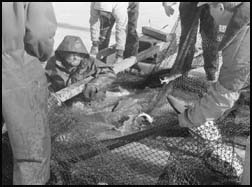 The carp population in Rice Lake lost thousands of members last week.
The carp population in Rice Lake lost thousands of members last week.A commercial fishing company from Lake Norden, S.D., caught 100,000 pounds of carp in two underwater nettings last week. The netting on Wednesday caught 58,000 pounds of fish and the one on Thursday caught another 42,000 pounds.
The fishing process starts by locating a concentration of fish using underwater sonar. Once one is identified in an area, holes are made to allow the nets to be lowered into the water. To spread out the nets, additional holes are drilled about 500 feet apart, and a rope attached to the net is brought under the ice to the new hole by a propeller-driven device. This device is remote controlled.
Once the device brings the rope to the new hole, winches on jeeps pull the net to that hole. Then another hole is drilled 500 feet further.
Eventually they make a huge circle and the ends of the net meet. Here they make a large hole, and then two huge winches pull the net out of the water. Someone needs to be in the water to walk the edges of the net onto the ice, keeping the fish from escaping. Other workers keep the net straight and remove fish caught in it.
At the end of the net is a bag which holds the fish. Game fish are removed from the net and released. The carp are transferred into holding nets until they can be shipped to a processing plant in Spirit Lake, Iowa.
Commercial fisherman Dave Raw said Monday that most of the fish had been shipped already. The carp are used to make a Jewish fish ball.
More carp may have been caught since press time. Raw expected to make another catch on Rice Lake yesterday.
His crew will try on Lake Koronis starting today. This schedule, however, depends both on the weather and on whether they find a big enough concentration of carp to make a netting worthwhile.
In 1995, 280,000 pounds of carp were removed from Rice Lake. In 1996, 192,000 pounds of carp were removed and 6,000 pounds of other species, including buffalo fish and bullheads.
Bruce Gilbertson, a Department of Natural Resources fishery officer in Spicer, said the removal of carp isnÕt a long-term solution for the reduction of the carp population. "The fish are really controlled by the habitat," he said. While the removal of carp may be noticeable for a short period, the carp will be replaced. "The lake habitat can still maintain rather high poundages of species like carp," Gilbertson said of Rice Lake.
According to Gilbertson, carp have been fished commercially for 70 years and it hasnÕt controlled their population. "It is not a way to effectively limit them," he said.
In small lakes, Gilbertson said, a large catch can reduce the population enough that it takes a few years for it to recover, but in a large lake like Rice, he said, the carpÕs high reproductive rate makes it possible to recover very quickly, depending on the lake conditions and the growing season.
Like human swimmers, game fish prefer clean water. Lower water quality gives species like carp a competitive advantage, by reducing game-fish predators, for instance.
"If we improve the water quality," said Gilbertson, "we should see more game fish."